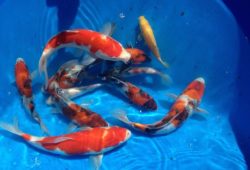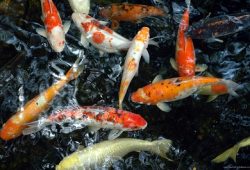Oranda Goldfish
The Oranda goldfish is at or near the top of any list of most popular types of goldfish. Others popular types include the Comet goldfish, the Fantail goldfish, the Celestial goldfish, and one which resembles the Oranda somewhat, the Lionhead goldfish. Goldfish are generally easy keepers, requiring for the most part sufficient food and clean water in order to thrive. The Oranda goldfish is no exception although there are a few noteworthy differences in the kinds of care it needs.

The Distinctive Wen
Call it a cap, a helmet, or a raspberry, the most striking feature of the Oranda goldfish, and one reason for its great popularity, is the growth which appears on the top and sides of its head, easily distinguishing the Oranda from other goldfish types or species.
This cap, more properly referred to as a wen, begins to form when the goldfish is a little more than a year old, and is usually more or less fully formed by the time the fish has reached the age of two. The wen will sometimes tend to grow larger with time. It may eventually totally cover the Oranda’s head, except for the eyes and the mouth, and in some case will even grow over one or both eyes.
While the wen at its most extreme could be considered disfiguring, in most cases it is very attractive, and even if it grows large enough to affect the Oranda’s vision, the fish seems to not be terribly bothered by the situation and is still able to swim and find food. One other type of goldfish, the Lionhead, also features this distinctive raspberry car.
Aside from the wen, the Oranda looks like a typical goldfish with a somewhat egg-shaped body, and an attractive split-fin tail. The Oranda comes in a variety of colors, though the pure white variety (with the red cap) appears to be the most popular. Some Oranda goldfish have shiny metallic scales, while others feature scales having more of a matte surface.
The Oranda is aptly described as either a fancy goldfish or an exotic goldfish. This might suggest that it’s therefore an expensive goldfish, but that isn’t true. It is quite abundant and relatively inexpensive, though due to its popularity, the white Oranda can sometimes be difficult to locate, and therefore can be a bit more pricey.
Special Considerations
The Oranda goldfish can be kept in the same aquarium with other goldfish types, but when introducing the Oranda with other types, there is sometimes the possibility that other fish may take an interest in the Oranda’s bright red wen. This usually doesn’t result in any problem for an Oranda, but there is always the exception, so it’s wise to check occasionally. When feeding a collection of goldfish, it’s wise to remember that the Oranda is strictly a bottom feeder, so fish flakes that float on the surface and are gobbled up by other goldfish types can leave the Oranda a little short-changed. The Oranda will need to be given food that can sink to the bottom so it can find it.
Warm And Clean Water Important
Two other considerations have to do with water temperature and water quality. The Oranda goldfish cannot tolerate cold water to the extent many other types of goldfish can, and the water temperature in the aquarium should not fall below 60 degrees. As far as water quality is concerned, the Oranda needs cleaner water than other goldfish types as its wen, when fully developed, has creases and crevices which can be a breeding ground for bacteria. Any goldfish type will benefit from a clean environment, but as far as the Oranda goldfish is concerned, clean water is more or less mandatory.



